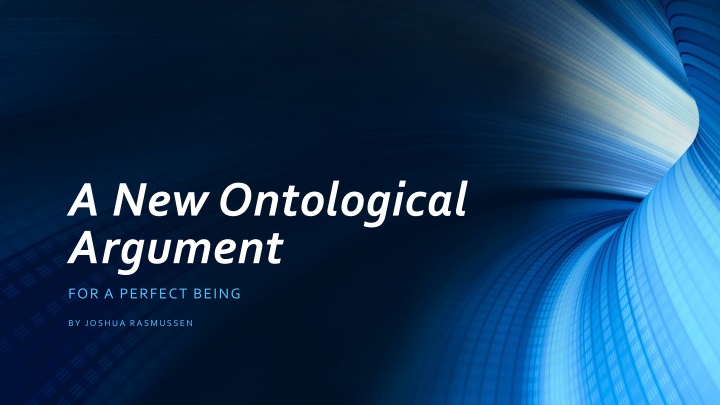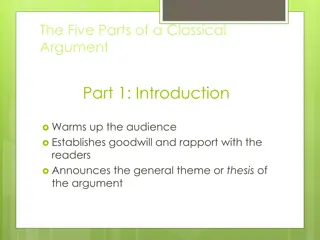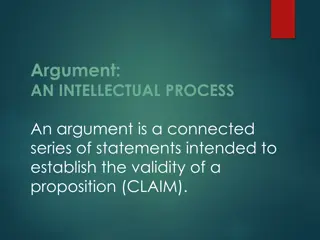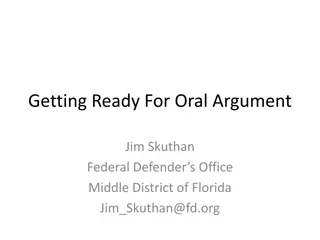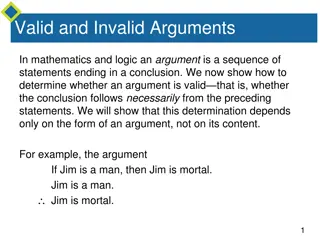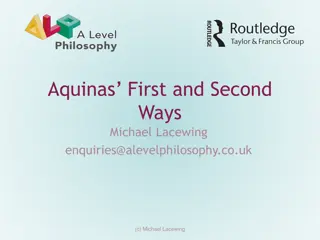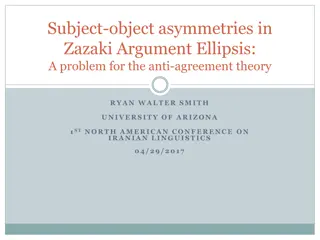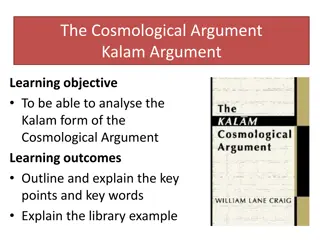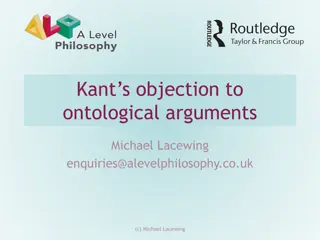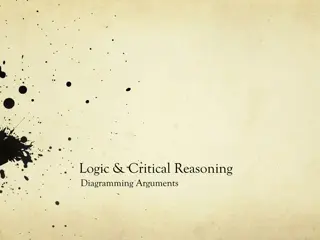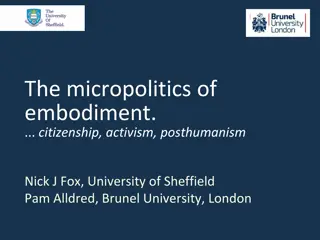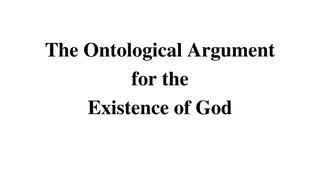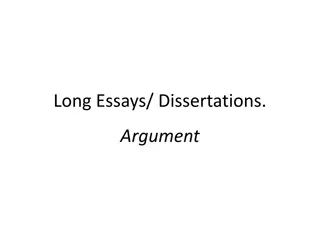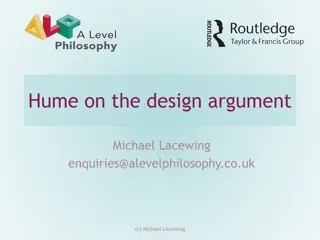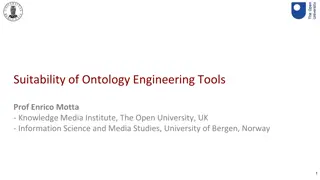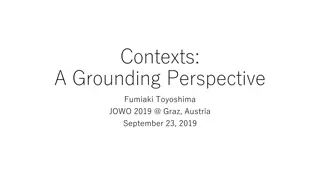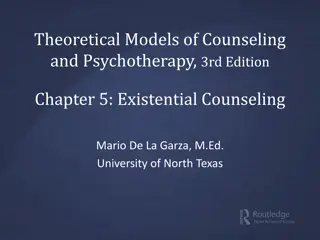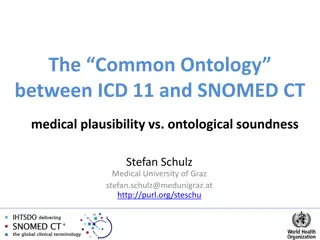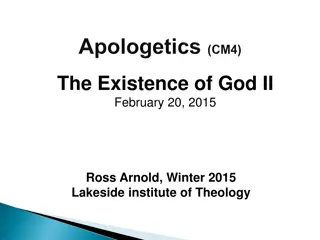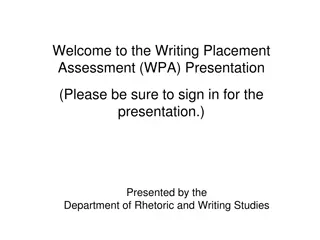A New Ontological Argument
Explore a pathway from the concept of God to the existence of God by examining obstacles in reasoning such as empty concepts, empty worlds, and the limits of reason. Refute misconceptions and provide a larger perspective on the results.
Download Presentation

Please find below an Image/Link to download the presentation.
The content on the website is provided AS IS for your information and personal use only. It may not be sold, licensed, or shared on other websites without obtaining consent from the author.If you encounter any issues during the download, it is possible that the publisher has removed the file from their server.
You are allowed to download the files provided on this website for personal or commercial use, subject to the condition that they are used lawfully. All files are the property of their respective owners.
The content on the website is provided AS IS for your information and personal use only. It may not be sold, licensed, or shared on other websites without obtaining consent from the author.
E N D
Presentation Transcript
A New Ontological Argument FOR A PERFECT BEING BY JOSHUA RASMUSSEN
Purpose To explore a pathway of reason from the concept of God to the existence of God.
Roadmap Step 1. Examine 3 obstacles to any such path. Step 2. Chart a potential way forward. Step 3. Provide a larger picture of the results.
Obstacle 1: Empty Concepts The empty concept principle: For any concept C, the mere existence of C does not entail the existence of what C is about. For example, the existence of the concept of a unicorn does not entail that any unicorn exists. Another example: the existence of the concept of a necessarily existent pizza does not entail that any pizza exist.
But The empty concept principle is false: Recall the principle: for any concept C, the mere existence of C does not entail the existence of what C is about. Consider the concept C of a concept. C cannot exist unless what it is about exists. Therefore, C is a counterexample. Another counterexample: the concept of a property. The concept of a property cannot exist unless that very concept has a property.
Obstacle 2: Empty Worlds The empty world principle: no concept picks out something that must exist. Whatever we conceive as existent, we can also conceive as non-existent -David Hume (Dialogues Concerning Natural Religion, IX)
But First, it is debatable whether abstracta necessarily exist. A realist perspective: the abstract mathematical landscape necessarily exist. Platonism: the empty world principle itselfcould only be necessarily true if it necessarily exists. (See my article, From Necessary Truth to Necessary Existence. ) Second, a case can be made for the necessary existence of fundamental reality. Any merely contingent, non-necessary realm would plausibly depend on prior conditions. See A. Prussand J. Rasmussen, Necessary Existence, Oxford University Press. Third, the empty world principle has not itself been established by any clear principle of reason that I know. So, the path remains wide open.
Obstacle 3: Limits of Reason Reason cannot by itself illuminate whether an empty world is possible. An Argument from Consistency: 1. If Reason couldilluminate whether an empty world is possible, then <there is nothing> would entail a contradiction. 2. The existential premise (Swinburne): no negative existential entails a positive existential (i.e., a contradiction). For example, <there are no unicorns> does not entail <there are unicorns>. Similarly, <there is no perfect being> does not entail <there is a perfect being>. 3. Therefore, reason cannot illuminate whether an empty world is possible.
But The existential premise is false: Recall the existential premise: no negative existential entails a positive existential. Consider this negative existential: <there are no truths>. That entails that <there are no truths> is true. Tarski s T-schema: p iffp is true. Therefore, <there are no truths> entails <there is a truth>, which is a contradiction.
The Path is Open Five ideas: 1. From the possibility of a maximally great being. E.g., Plantinga s ontological argument. These face the problem of reverse arguments from the possibility of not God. Recent developments focus on symmetry breakers. 2. From the existence of abstracta. E.g., conceptualist arguments. 3. From the mental nature of reality. 4. From the explicability of imperfect things. 5. From the positivity of perfection.
From the Positivity of Perfection Seed idea: God is too great not to exist An early form of this idea sprouted into Anselm s Argument from Greatness: 1. God either exists only in one s mind or also in reality. 2. If God only exists in one s mind, then God is not the greatest conceivable. 3. God, by definition, is the greatest conceivable. 4. Therefore, God exists in reality also.
The Standard Analysis When we make the Argument from Greatness precise, we can see it is either invalid or question-begging. Recall the first premise: God either exists only in one s mind or also in reality. The term God either picks out the concept of God, or it picks out God. If God picks out only the concept of God, then the argument only shows that the concept of God exists (in both one s mind and reality). If God picks out God, then the first premise is question-beginning: i.e., it presupposes the existence of the very thing to be argued for.
A Gdelian Development We can look throughthe concept of God to see a perfect nature (absolute perfection), which may or may not be exemplified. We can then inspect properties of this nature to see its positivity. G del identifies a link between the positivity of a nature and its exemplification. Big Question: is it possible to derive the exemplification of perfection from its positivity?
One Morning I woke up with the following thought: No positive property entails a negative property.
The Entailment Line 1. No positive property entails a negative property. 2. Absolute perfection is positive. 3. Therefore, absolute perfection does not entail a negative property. 4. Impossible properties entail every property (by explosion). 5. Therefore, absolute perfection is possible (possibly exemplified). 6. A perfect being would span all possible worlds if any. Necessary perfection is positive. Absolute perfection includes all atomic positive properties. 7. Therefore, absolute perfection is actual (actually exemplified).
My Worry Parody 1. No shape entails a sensation. 2. A maximally sided shape is a shape. 3. Impossible properties entail everything (including sensations). 4. Therefore, a maximally sided shape is possible!
Diagnosing the Problem The problem is with seeing non-entailments. Recall the entailment premise: no shape entails a sensation. We may not see an entailment between a shape and a sensation. But not seeing entailment is not same as seeing a non-entailment. To see that no entailment holds requires that we see the non-entailment between every shape and a sensation.
Diagnosing the Problem (Cont.) The same problem applies to the G delianargument. Recall premise (1) of the G delianargument: no positive property entails a negative property. Do we see the non-entailment between positive and negative properties? Or do we merely fail to see the entailment? For all we see, perhaps positivity does entail negativity (e.g., by explosion).
A Potential Way Forward There is a difference between a maximal shape and a perfect nature: A maximal shape has no intrinsic property that sheds light on whether or not it might entail via explosion a sensation. By contrast, a perfect nature has a purely positive aspect. We are not in the dark about the contents of a perfect nature. A perfect nature includes purely positive properties: e.g., perfect knowledge, perfect goodness, supreme power, maximally robust existence. These are all intrinsically positive. Can this purely positive aspect shed light on whether a perfect nature entails a negative property?
The Argument from the Positivity of Perfection 1. A perfect nature is purely positive. 2. No purely positive nature hasa negative property. 3. The property of entailing a negative property is negative. 4. Therefore, a perfect nature (absolute perfection) does not entail a negative property.
Putting the Argument Together: The New Ontological Argument from Perfection 1. There is a concept of a perfect being. 2. If there is a concept of a perfect being, then there is the property P of being absolutely perfect. P constitutes the sharable ( narrow content ) of the concept of a perfect being. 3. P does not entail anything negative. By the Argument from the Positivity of Perfection. 4. Therefore, P is possible. 5. An instance of P (a perfect being) spans all worlds if any. 6. Therefore, a perfect being exists in the actual world.
The Island Parody 1. There is a concept of a perfect island. 2. If there is a concept of a perfect being, then there is the property S of being a perfect island. 3. S does not entail anything negative. By the Argument from the Positivity of Perfect Islands. 4. Therefore, S is possible. 5. An instance of S (a perfect island) spans all worlds if any. 6. Therefore, a perfect island exists in the actual world.
Reply to Parody The Island Parody fails to be parallel. Consider the Argument from the Positivity of Perfect Islands: 1. A perfect island nature is purely positive. 2. No purely positive nature hasa negative property. 3. The property of entailing a negative property is negative. 4. Therefore, a perfect island nature does not entail a negative property. Root problem: a perfect island nature is not purely positive. Every conceivable island is fundamentally limited in power, knowledge, or goodness. The only nature that would be purely positive is a perfect nature i.e., the nature of a perfect being.
A Remaining Worry Could there be a negative property hiding inside the concept of a perfect being?
A Final Consideration A web of interlocking ideas can be mutually reinforcing. The positivity of perfection unlocks a solution to the Problem of Inexplicable Existence. The Problem of Inexplicable Existence: what explains the difference between explicable parts of reality and the inexplicable whole? In other words: how can any reality be foundational, without any further explanation? Enter perfection: being perfect entails being ultimate and foundational. All imperfect things, by contrast, can consistent with reason have a further explanation.
A Model of a Perfect Foundation The fundamental layer of reality has a perfect nature: 1. This layer is not a turtle. 2. It is not blue. 3. It has no arbitrary limits or qualities. 4. It is purely good, unrestricted in power, and the foundation of all that we see. 5. It contains necessary pillars of reason (the logical landscape). 6. It anchors every dimension of reality (moral, mental, material, etc.). 7. In its substance, all things live and move and have their being.
Three Advantages of the Perfect Foundation Model 1. Solves the Problem of Inexplicable Existence. 2. Has the widest predictive success in the most parsimonious way. 3. Fits perfectlywith the Ontological Argument from Perfection.
